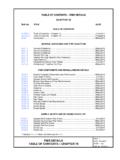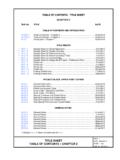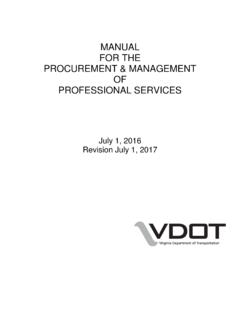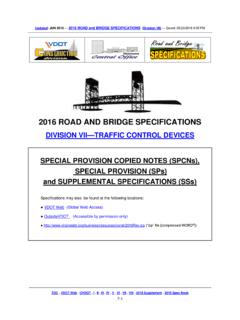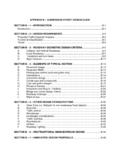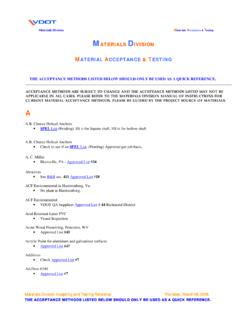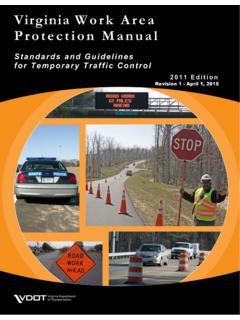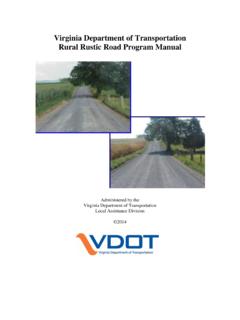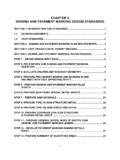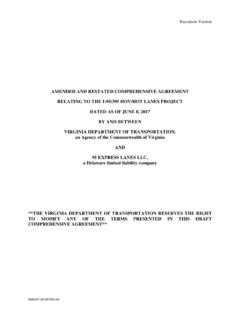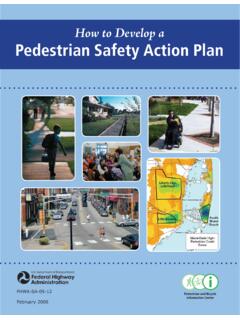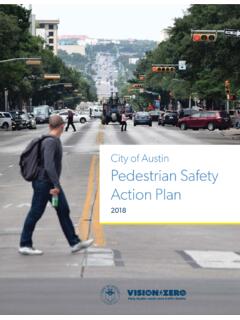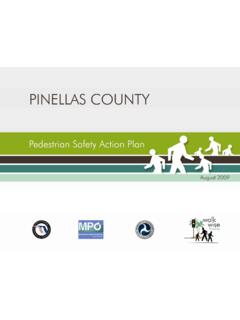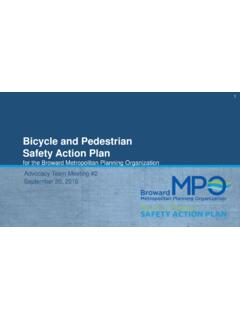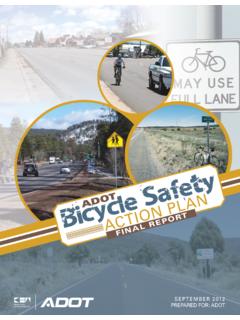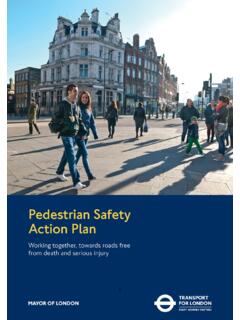Transcription of Virginia Department of Transportation State Pedestrian ...
1 Virginia Department of Transportation State Pedestrian Policy PlanSeptember 2014 Executive SummaryWalking is a popular activity for both Transportation and recreation in Virginia . Residents and visitors to the Commonwealth walk to access transit, to shop, for pleasure, and for exercise. They walk on sidewalks along busy urban streets, along quiet rural roads and neighborhood streets. The Virginia Department of Transportation (VDOT) supports the provision of a multi-modal Transportation system that addresses the needs of pedestrians.
2 In 2004, the Commonwealth Transportation Board (CTB) adopted the Policy for Integrating Bicycle and Pedestrian Accommodations (also called the Policy). The Policy provides the framework through which VDOT accommodates bicyclists and pedestrians in the funding, planning, design, construction, operation, and maintenance of Virginia s Transportation network. This plan is the second of three plans that seek to build on the advances made through the creation of the Policy. The first plan focused on State policy regarding bicycling and was released in September 2011.
3 The final plan will address the implementation element of both the bicycle and Pedestrian policy plans. The purpose of this plan is to establish a vision for the future of walking in the Commonwealth and to advance the walking element of the Policy consistently, appropriately, and cost-effectively. The final plan will address the implementation element of both the bicycle and Pedestrian policy plans. The recommendations in this plan will advance the Policy more effectively and will involve a wide variety of partners within various divisions of VDOT, as well as stakeholders throughout the Commonwealth.
4 This plan focuses on policies, procedures, and programs within VDOT s authority. The development process for the State Pedestrian Policy plan involved coordination with key stakeholders and agency staff within VDOT as well as other agencies. The effort was led by an internal working group that consisted of VDOT staff and an external working group that was comprised of representatives of localities, Metropolitan Planning Organizations and the Federal Highway Administration. In addition, the Virginia Bicycle and Pedestrian Advisory Committee provided comments to refine this VDOT State Pedestrian Policy plan was created to achieve several goals: Goal 1: Improve the safety and comfort of pedestrians throughout Virginia and reduce Pedestrian related crashes.
5 Goal 2: Enhance mobility and accessibility for pedestrians. Goal 3: Achieve a more connected Pedestrian network in Virginia . Goal 4: Better promote and educate planners, designers, advocates, and stakeholders on the requirements of the CTB Policy for Integrating Bicycle and Pedestrian Accommodations. Goal 5: Improve available guidance on Pedestrian CONDITIONSV irginia has a mix of opportunities and constraints to walking as well as a wide variety of conditions that impact Pedestrian safety and comfort. There are many walkable downtown areas throughout the Commonwealth where walking is safe and convenient, while in other locations walking is difficult due to lack of sidewalks, crosswalks and long crossing distances.
6 There are a variety of opportunities to improve walking conditions and local jurisdictions throughout the Commonwealth are eager to make walking a more viable option for their residents and is home to an outstanding variety of walking opportunities from quaint downtowns to Pedestrian malls and long-distance hiking trails. With support from VDOT, localities throughout Virginia are focusing more attention on the economic and quality of life benefits of walkable communities and are working to connect residential areas, shopping areas, recreation facilities, places of work, and schools.
7 While there are sidewalks on the ground today, there are many gaps in these networks that need attention. The Commonwealth Transportation Board s Policy will continue to serve a very important role in filling these RECOMMENDATIONSThe recommendations of this plan are organized under four core elements, as discussed below. More detail and specific recommendations are provided in Section 5. ELEMENT 1: CLARIFY POLICIES WITH REGARD TO Pedestrian should provide additional guidance on the planning, design, operation, and maintenance of Pedestrian facilities.
8 In some cases, this will involve clarifying or revising existing departmental policies and procedures. In other cases, it will involve developing new resources to guide the implementation of the Policy across all disciplines of the Department . For example, procedures are needed to clarify the appropriate type or level of Pedestrian accommodations in different roadway environments. ELEMENT 2: PROVIDE STAFF WITH RESOURCES TO INTEGRATE THE ACCOMMODATIONS OF PEDESTRIANS IN PROJECTS AND has policies and design standards that address the needs of pedestrians.
9 However, these policies are still fairly new and are being incorporated into the daily operating procedures of the Department . The Bicycle and Pedestrian Program provides guidance for this process. VDOT staff should receive training and guidance on their job responsibilities in order to ensure they are able to design, construct, operate, and maintain roadways that safely and appropriately accommodate walking as a multimodal option. ELEMENT 3: IMPROVE OUTREACH AND addition to VDOT, there are many other agencies and organizations in the Commonwealth responsible for implementing Pedestrian projects and programs.
10 A high level of coordination among these entities will benefit stakeholders and the general public. VDOT should continue to coordinate, where appropriate, on Pedestrian efforts with local government staff, Metropolitan Planning Organizations, parks and recreation departments, Planning District Commissions, other State agencies, and non-profit organizations including advocacy groups. ELEMENT 4: MEASURE AND EVALUATE monitoring and evaluation of Pedestrian performance measures will help ensure that walking is included in the everyday operations of VDOT so Virginia can continue moving toward a truly multimodal Transportation network.
